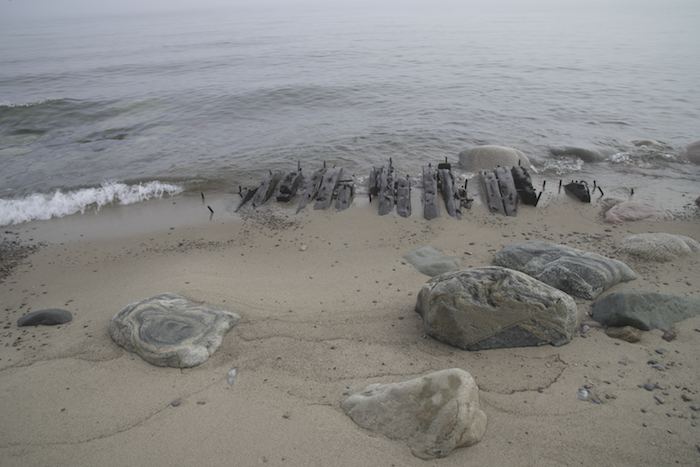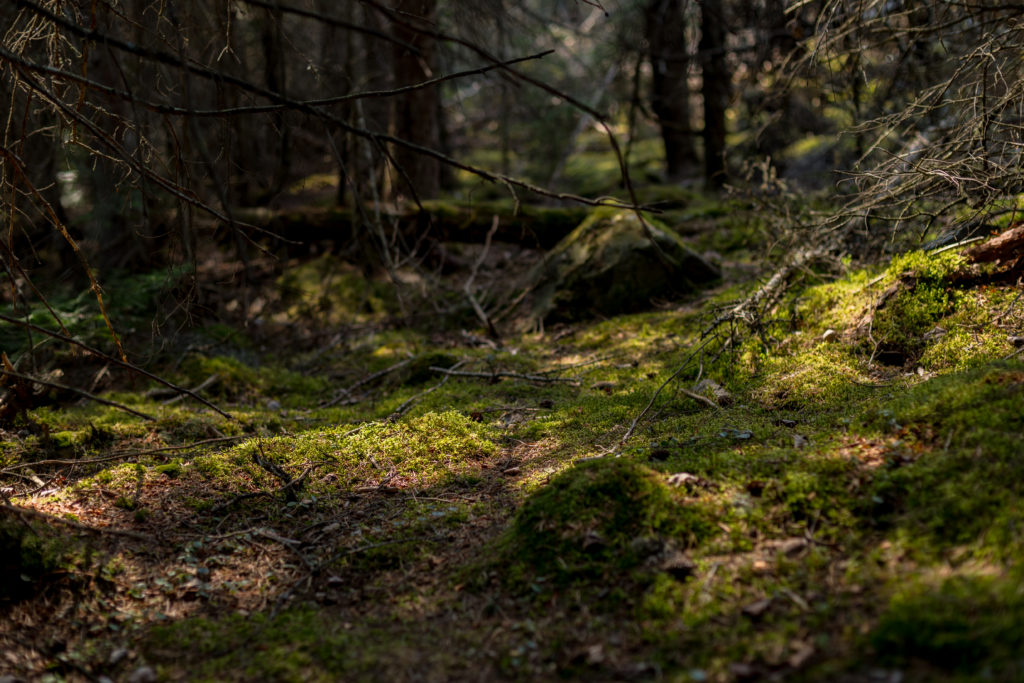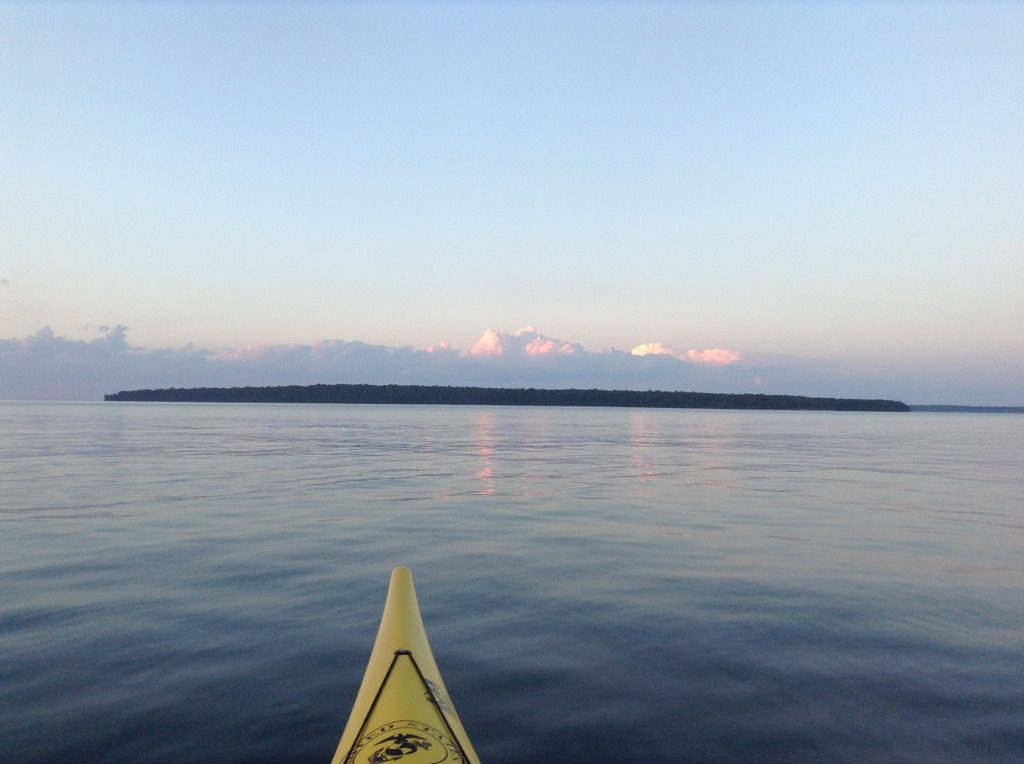
Shipwreck at Pictured Rocks. Photo: Steve Brimm Photography.
Editor’s Note: Composer Libby Meyer, a member of the Landscape Music Composers Network, writes her first essay for Landscape Music about her NEA-funded project “Listening to Parks.”
Apostle Islands Rain in a Pressure Cooker. Recording by Libby Meyer.
I found myself in a tent during a thunderstorm on Ironwood Island in the Apostle Islands National Lakeshore on a Thursday evening in August eating rice and beans with my husband and recording the sound of rain falling into my pressure cooker with a hydrophone. That evening, we would later find out, a young man had drowned in 8-foot waves off of Stockton Island about ten miles east of our campsite. We had listened to the rescue attempt on our marine radio: helicopters in the background and reports of sightings. We learned from a ranger, who had come to clean the outhouse on Otter Island where we camped the next day, that his body had been found. While we were listening to rain and enjoying our dinner, safe and warm in our tent, someone was losing his life. Vulnerability is relative.
* * *
“We have work to do.”
Four months earlier, a late night text from my colleague and sound designer, Chris Plummer, announced that we—along with designer Kent Cyr—were awarded a grant from the National Endowment for the Arts as part of the National Park Service Program Imagine Your Parks. My initial reaction was one of elation. This was quickly followed by something closer to panic: “Now we really have to do this.”
For our project, entitled “Listening to Parks,” we are recording soundscapes at Isle Royale National Park, The Apostle Islands National Lakeshore and the Keweenaw National Historical Park (KNHP). I will be composing a piece based on these recordings and my impressions of the Parks to be premiered by the Keweenaw Symphony Orchestra in December 2017. Our team will design a multi-media sound installation utilizing collected images, music, video, and audio recordings, which will tour to locations in Michigan, Wisconsin and Minnesota. We will work with with K-12 students and teachers in our region, utilizing our project to promote enjoyment, stewardship, and lifelong learning through the National Parks. In addition to our funding from the NEA, we were subsequently awarded funding from the National Parks of Lake Superior Foundation to include another two national parks on Lake Superior: Pictured Rocks National Lake Shore and Grand Portage National Monument.

Isle Royale. Photo: Chris Plummer.
I am now faced with a challenge. How does one tell the story of these Parks through sound? What connects these special places and what is our connection to them? I have spent many years living on the shores of Lake Superior. I have paddled in the Apostle Islands in the summers and snow shoed to the ice caves in the winter. I was an Artist in Residence at Isle Royale National Park and have spent time hiking and paddling at Pictured Rocks National Lakeshore. But once I embarked on this project, I was overwhelmed by its magnitude.
Loon Calls at Isle Royale National Park. Recording by Erik Doering.
Each park has its own unique story and collection of soundscapes: the sea caves of the Apostle Islands, the loons of Isle Royale, or the rushing waterfalls of Pictured Rocks. Then there’s the Keweenaw National Historical Park and its 21 Heritage Sites, including everything from the Quincy Mine Hoist to the Historic Calumet Theater: a turn of the century Opera House. The KNHP exists to document the story of settlers from all over Europe to Michigan’s Upper Peninsula, drawn by new opportunities in the copper mines, and their challenges with the severe environment of this region. Finally, Grand Portage National Monument is a 19th Century fur trading post where the Ojibwa and the French Voyageurs traded beaver pelts to be sent to Western Europe to become ladies’ hats, an extremely popular fashion of the time.

Apostle Islands. Photo: Evan McDonald.
After spending a summer in the field and visiting many of the Heritage Sites to appreciate their unique connection to the “Big Lake” (as we like to call it up here), as well as through conversations with my colleagues on the project and biologists and ecologists working in the field of conservation, I have landed upon the idea of the many, often conflicting understandings of “Wilderness.” It’s a term that is often used but rarely defined. It can have both positive and negative associations. I have set out to explore what Wilderness means to me both as an artist and as a human being. With Wilderness quickly disappearing and being dramatically altered through climate change and other human activities, what is its connection to human life on this planet? Is it just the opportunity to visit beautiful places and enjoy the view? Or is it something deeper? What is the role of our National Parks and other special places? Does Wilderness end at the Parks’ borders or do we take it with us when we leave? I have discovered through this process that I have many more questions than answers.
With this feeling of vulnerability also comes a feeling of Wonder.

Libby Meyer Recording at Apostle Islands. Photo: Evan McDonald.
How can I possibly capture this sense of Wilderness and Wonder through sound? I am in the process of answering this question for myself as well as posing that question to others. Over the next year I will be exploring this very idea of Wilderness, composing my own music as well as utilizing the folk songs of our region and recordings of industrial and ambient sounds from the Heritage Sites, oral histories from the KNHP, the Ojibwa language and Native American song from Grand Portage, and soundscapes from the Apostle Islands, Pictured Rocks and Isle Royale. I will also be looking at the challenges to our parks: the wolf reintroduction controversy at Isle Royale, as well as the affects of climate change on our Parks. I aim to examine not only my understanding of Wilderness, but also how the definition has changed in the hundred years since the creation of the National Park Service. This is a daunting task. But I am hopeful that, through accepting the vulnerability that Wilderness presents to me, I will be able to listen and tell the tale.
Learn more about the Listening to Parks project and the Keweenaw Soundscape Project, or check out Libby Meyer‘s biography and samples of her music.
